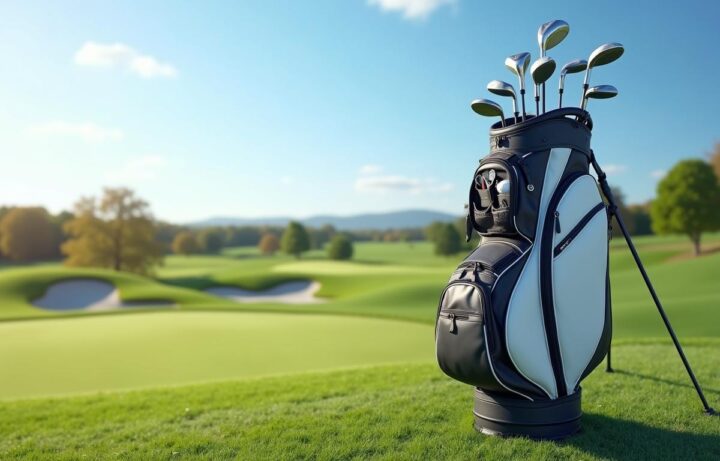How to Organize Golf Bag for Better Play and Club Protection
Proper golf bag organization can substantially affect your game. You’ll spend less time searching for gear but how to organize golf bag? A standard golf bag comes with 14 separate compartments that protect each club from damage during transport and play.
Players who quickly learn proper bag organization enjoy smoother rounds and better performance. The right bag makes a difference – whether you choose a lightweight 3-pound Ping Hoofer Craz E-Lite or a Sun Mountain C-130 cart bag with 14 full-length dividers. Your clubs need protection and easy accessibility.
A logical arrangement starts with woods on top, followed by long irons, mid-irons, and wedges. This setup boosts your playing experience. Professional organization techniques will protect your clubs and help improve your performance on the course.

Choosing the Right Golf Bag for Your Game
The right golf bag sets the foundation for keeping your equipment organized. Your playing style should determine which bag you choose. A perfect bag strikes the right balance between storage space, weight, and features that match how you play the course.
Stand Bags vs. Cart Bags vs. Travel Bags
Stand bags give versatility to golfers who like walking the course but need convenience and organization. These light options (usually 3-7 pounds) come with retractable legs that keep the bag upright, so you can reach your clubs without putting them on the ground. Most stand bags have comfortable dual shoulder straps that spread weight evenly across your body and reduce tiredness during those long par 5s.
Cart bags are built for golfers who use riding or push carts. These bags weigh more (5-9 pounds) and feature a flat, non-slip base that locks them to the cart. Cart bags shine with their forward-facing pockets that you can easily reach when they’re strapped to a cart. This design makes it simple to grab your clubs during play.
Travel bags serve a unique purpose. These specialized bags keep your equipment safe during transport. They come with strong padding, sturdy wheels, and reinforced build to protect your clubs when you’re flying or driving to far-off courses. Many models have extra room for shoes and accessories, which makes them perfect for golf trips.
How Bag Type Affects Club Organization
Your choice of bag shapes how you’ll arrange your clubs. Stand bags usually have 4-6 way dividers, so you’ll need to group similar clubs together instead of giving each one its own space. This needs careful planning to stop clubs from getting tangled or damaged.
Cart bags often come with 14-way divider systems where each club gets its own slot. This setup takes the mystery out of organizing since every club has a specific spot. You should point club heads away from the cart for quick identification and easy removal.
Both bag choices follow one basic rule: arrange different types of clubs from longest to shortest. Put woods and drivers at the top (near the bag handle), then long irons, mid-irons, and finally, wedges and putter at the bottom. This order makes picking clubs easier during your round.
Why Divider Count Matters
The number of dividers in your bag affects how well you can organize and protect your clubs. Dividers range from basic 2-way systems in Sunday bags to premium 14-way setups.
Full-length dividers reach the bottom of the bag and give the best protection by keeping clubs apart. They prevent the frustrating “club tangle” that can harm shafts or grips. Premium bags often include rubber slots that lock clubs in place and stop movement during transport.
The number of clubs you carry should help decide your divider system. A 4-way divider works great if you carry fewer clubs, letting you put 2-3 clubs in each section. A 14-way system with full-length dividers gives the best protection and organization, especially for custom-fitted clubs that need extra care.
Divider systems also cut down on noise from clubs hitting each other, which can throw off your game. They make cleaning clubs easier too, since each one stays in its assigned spot.
How to Organize Golf Clubs in Bag for Maximum Efficiency
A well-organized golf bag does more than just hold your equipment – it becomes your strategic asset on the course. The right organization of your golf bag contents will protect your clubs and save you valuable minutes during each round.
Top to Bottom: Longest to Shortest
The basic principle of golf club organization follows simple logic: arrange your clubs from longest to shortest, top to bottom. This setup keeps shorter clubs from damaging the graphite shafts of longer ones. Stand bags and push carts need longer clubs at the top (near the strap/handle) with shorter clubs at the bottom. Cart bags work differently – you’ll want to arrange longest to shortest from back to front since they’re designed to be accessed when strapped to a cart.
Woods and Hybrids Placement
Your woods and driver should sit in the top section of your bag (or back section for cart bags). These clubs need extra care because of their graphite shafts and sensitive clubhead materials. Headcovers are a must to avoid scratches and extend club life. Premium bags come with recessed areas that create extra space for longer wood and hybrid headcovers. The driver works best in the center with fairway woods on each side. This setup keeps your clubs safe yet ready to use.
Mid-irons and Wedges Grouping
Long irons (or their hybrid replacements) should follow your woods. Your mid-irons (7,8,9) and pitching wedge fit naturally in the next section. A 4-divider bag works best with irons and wedges in the two middle dividers, arranged by number from longest to shortest. This layout lets you grab the right club quickly during play.
Where to Place Your Putter
Your putter’s home depends on your bag style. Modern bags often feature a special putter slot or easy-access position. Many golfers who use stand bags keep their putter at the top among other head-covered clubs for protection. Cart bags usually have the putter in the bottom row next to specialty wedges. A putter cover is essential whatever the position – it guards the delicate face and shaft from performance-affecting scratches.
Using Club Dividers for Protection
Dividers serve as more than organizers – they shield your clubs from damage. Clubs can weaken over time if they knock against each other while walking or riding. Poor organization might lead to club failure during impact, which can get pricey. Full-length dividers that reach the bag’s bottom give the best protection by keeping clubs separate. Some high-end bags feature rubberized slots that hold clubs firmly and prevent rattling. These dividers help maintain your expensive fitted clubs in top shape, ready to be cleaned and maintained properly.

How to Organize a Golf Bag by Pocket Function
Smart organization of golf bag pockets creates a system where everything has its place. Your pocket organization is a vital part of your setup, just like club arrangement for quick play. Modern golf bags come with multiple specialized compartments, and knowing exactly where everything goes can help you maintain your rhythm instead of wasting time searching for gear.
Ball Pocket, Tee Pocket, and Apparel Storage
The best way to organize your golf bag storage starts with managing your balls. Most amateur players should pack plenty of breakfast balls for their golf round. Professional golfers usually carry 9-10 golf balls for an 18-hole round, while beginners might need 12-13 to cover potential losses. The ball pocket sits at the front bottom of your bag and should hold only golf balls, which lets you check your inventory quickly.
Small accessories need their own space. The smallest pocket in your bag works perfectly for tees, ball markers, and divot repair tools. Keeping these items separate will protect your other equipment and give you quick access during play. Your golf glove should stay out of this pocket to avoid unnecessary wear.
Your apparel pocket needs special consideration. Golf bags typically include at least one full-length apparel pocket designed for clothing. This space holds your rain gear, jackets, and extra gloves that you might need as weather shifts. Food, tees, or other small items should stay out of this compartment since they can get lost in the lining or damage your clothes.
Valuables and Electronics Compartment
Modern bags include a special valuables pocket with fleece or velour lining. This pocket protects your wallet, phone, keys, and watch from scratches and moisture. Premium models often feature waterproof valuables pockets that give extra protection for electronics during surprise rainfall.
Rangefinders and other golf technology need pockets with extra padding or hard shells. These specialized compartments protect your devices and let you access tools that help determine club selection based on your next shot.
Insulated Pockets for Snacks and Drinks
Quality golf bags now come standard with insulated cooler pockets that keep your refreshments at the right temperature. These spaces typically fit six to seven 12-ounce cans or a one-liter bottle and maintain temperature for 4-6 hours – enough time for a complete round.
Consumable items should sit at the top of insulated pockets to avoid melting or spoiling in rising temperatures. This setup keeps your custom fitted clubs as the main focus while keeping refreshments ready when you need energy on the course. After playing, clean your clubs and empty these pockets to stop mold or odors from forming.
Maintaining Balance and Weight Distribution
A balanced golf bag makes your game more enjoyable and protects your equipment. The right weight distribution in your golf bag can transform a tiring round into a comfortable experience. Smart organization of weight needs careful planning since it affects both your game and physical comfort.
Why Weight Matters for Carry and Cart Bags
Your golf bag’s weight balance plays a crucial role in protecting your clubs. Poorly distributed weight can make bags tip over and damage your clubs. A well-balanced stand bag stays upright and stable on the ground. Cart bags need different weight arrangements to stay steady during transport. A balanced bag safeguards your investment and reduces wear on your equipment and body.
Tips to Avoid Tipping or Shoulder Strain
Snug dual straps against your back will prevent shoulder strain while carrying your bag. Equal strap lengths help the bag rest evenly on your shoulders and eliminate discomfort. The weight spreads across both shoulders instead of straining one side.
Stand bags come with dual strap systems built for balanced weight distribution. Your bag will shift during play, so adjust the straps as needed. Good carrying technique matters just as much as proper organization.
How to Pack Heavier Items Smartly
Pack your golf bag with heavier items at the bottom to improve stability on carts or shoulders. Stand bags work best with woods and drivers placed near the straps at the top for better balance while carrying or standing.
Lower pockets should hold golf shoes, extra balls, and rain gear to counterweight the club heads. Spread accessories evenly across pockets rather than loading one side heavily. Clean your clubs before putting them back in their spots to maintain organization and extend equipment life.
Your custom fitted golf clubs deserve protection through smart weight distribution that keeps both you and your equipment in top form.

Pro Tips to Keep Your Golf Bag Organized on the Course
Professional golfers stand apart from amateurs by their on-course habits and golf bag organization. The most organized equipment can turn into chaos during play without good routines. My worldwide travels to different courses have taught me that daily organizational habits matter just as much as the original setup.
Return Clubs to Their Slots after Each Shot
The foundation of golf bag maintenance lies in putting each club back in its designated slot right after use. This basic habit stops clubs from hitting each other and damaging graphite shafts. You’ll never see professional golfers place clubs against their bags or on the ground between shots. Make returning your club to its proper home as natural as your follow-through after each swing. Your golf clubs will stay protected throughout the round this way.
Use a Pre-round Checklist
A pre-round checklist changes golf bag organization from a one-time job into a reliable system. Check your balls, tees, gloves, and refreshments before you head to the first tee. Your rangefinder should have fresh batteries and your putter cover should be secure. This quick check will save you from finding missing essentials mid-round when replacement options are limited.
Clean Out Trash and Extras Regularly
Weekly reviews are vital to keep your golf bag organized. Old scorecards, broken tees, food wrappers, and unnecessary items pile up faster than you’d expect. Most golfers carry double the equipment they need. Your round becomes more comfortable and organized when you remove extra balls and unwanted items.
How to Clean Your Clubs and Bag
Regular cleaning forms a big part of proper golf club organization. Monthly deep cleans will make your equipment last much longer. Clean your clubs with warm water and mild dish soap, use a soft-bristled brush for grooves, and dry them with microfiber cloths.
Your bag needs hoovering up in interior compartments and wiping on exterior surfaces. Let everything dry fully before putting your bag back together to avoid mildew. Custom fitted golf clubs need this regular care to maintain their performance and protect your investment.
How to Organize Golf Bag Frequently Asked Question
How should I Arrange My Golf Clubs in My Bag?
Organize your clubs from longest to shortest, top to bottom. Place woods and drivers at the top, followed by long irons, mid-irons, and finally wedges and putter at the bottom. This arrangement protects your clubs and makes selection more intuitive during play.
What’s the Best Way to Protect My Golf Clubs during Travel?
Use a travel bag with robust padding and consider a hard-sided option for extra protection. Wrap club heads in towels or bubble wrap, use headcovers for woods and hybrids, and secure clubs with straps or towels to prevent shifting. Fill empty spaces with packing materials to minimize movement.
How can I Maintain the Organization of My Golf Bag during a Round?
Return clubs to their designated slots immediately after each shot. Use a pre-round checklist to ensure you have all necessary items. Regularly clean out trash and unnecessary items from your bag. Perform monthly deep cleans of both your clubs and bag to maintain organization and equipment longevity.
Where should I Store My Umbrella in My Golf Bag?
Most golf bags have a dedicated sleeve or holder on the side or back for umbrellas. If your bag doesn’t have one, you can use a pouch or pocket for a compact umbrella, or secure it with bungee cords. Consider using a golf-specific umbrella designed for easy one-handed operation.
How do I Organize the Pockets in My Golf Bag?
Dedicate specific pockets for different items. Use the ball pocket for golf balls only, a small pocket for tees and markers, and a full-length pocket for apparel. Store valuables and electronics in a fleece-lined pocket, and use insulated pockets for snacks and drinks. This system ensures quick access to all your gear during play.
What Items Should I Always Keep in My Golf Bag?
Essential items include golf balls, tees, a ball marker, divot repair tool, rangefinder or GPS device, sunscreen, a towel, rain gear, a scorecard, and pencils. Including a first aid kit and extra gloves can also prepare you for unexpected situations on the course.
How Often Should I Clean My Golf Clubs and Bag?
Wipe down your clubs after each round to remove dirt and grass. Perform a deeper clean monthly by soaking club heads in warm, soapy water and scrubbing with a soft brush. Clean your bag’s pockets and exterior with a damp cloth, and let it dry fully before storing.
Can I Customize My Golf Bag for Better Organization?
Yes, many bags have adjustable dividers and removable pouches. You can also label pockets or use small containers to group smaller items like tees or ball markers. Some golfers attach accessories like club brushes, towels, or GPS mounts for added convenience.
What’s the Best Way to Store My Golf Bag at Home?
Keep your bag in a cool, dry place, away from direct sunlight or moisture. Use a stand or wall-mounted rack to avoid bending clubs. Remove all perishables or electronics between rounds, and periodically check for mold, rust, or damage.
Should I Use a Stand Bag or Cart Bag for Better Organization?
Stand bags are lightweight and ideal for walking golfers, while cart bags offer more storage and organizational features, including more pockets and dividers. Choose based on how you typically play and prioritize portability versus storage capacity.


